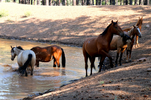Woodhouse's Toad
Anaxyrus woodhousii

Listen for long trills near water
Woodhouse’s toad is a medium-sized amphibian native to Arizona, recognized by its warty skin, robust body, and prominent parotoid glands behind the eyes. Commonly found throughout forested areas, riparian zones, and desert washes, it is highly adaptable to a variety of habitats. Woodhouse’s toads are primarily nocturnal, emerging at night to feed on insects, spiders, and other invertebrates. During the rainy season, males produce distinctive trilling calls to attract mates. As both predator and prey, they play an important role in controlling insect populations and supporting the diets of snakes, birds, and small mammals, making them a vital component of Arizona’s ecosystems.
Amphibian

Identification & Behavior
Key Features: Brownish-gray with warty skin
Size: 2–3 in
Behavior: Calls loudly during rainy season, hides under rocks
Diet: Insectivore
Activity Pattern: Nocturnal
Habitat & Distribution
Found statewide in Arizona, primarily in deserts, grasslands, and riparian areas, often near ponds, streams, irrigation canals, or ephemeral pools. Prefers lowland and foothill habitats but can occur at elevations up to 7,000 feet. Commonly seen in areas such as the Sonoran Desert valleys, Mogollon Rim foothills, and Verde and Gila River corridors. Present in Coconino, Apache-Sitgreaves, Tonto, Prescott, and Coronado National Forests where suitable water sources are available for breeding.
Elevation Range: 4,000–8,500 ft
Seasonal Presence: Spring–Summer
Risks & Management
Do not handle frequently; amphibians sensitive





























